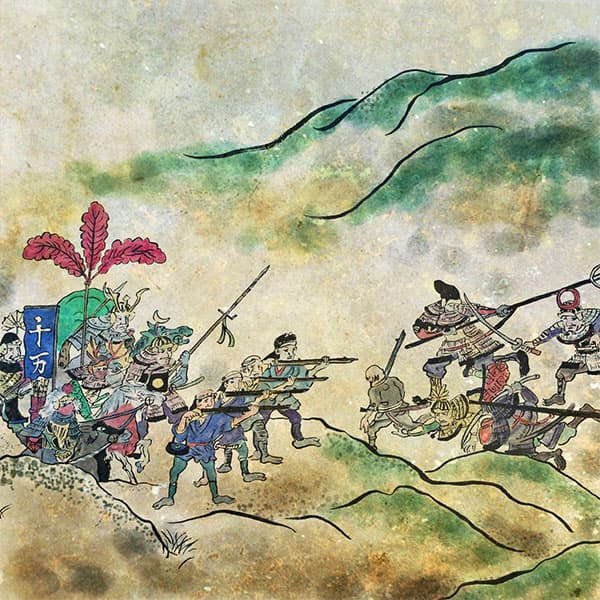- Yamagata domainRuled by many fudai daimyo
- The Yamagata domain was founded by Yoshimitsu Mogami, who fought with Date Masamune for supremacy in Oshu. However, after Yoshimitsu Mogami's death, the Mogami family caused a number of disturbances and was abolished, and after that, many feudal lords and relatives, including the Torii clan, ruled the domain. The Yamagata clan

Yamagata CastleYamagata City, Yamagata Prefecture
- TOP
- Tohoku
- Yamagata Prefecture
- Yamagata Castle
| Other name | Kasumigajo, Kasumigajo, Yoshiji Castle |
|---|---|
| castle construction | 1356 |
| address | 3 Kajocho, Yamagata City, Yamagata Prefecture |
Yamagata Castle is selected as one of Japan's top 100 castles.
- Access to Yamagata Castle
- Approximately 8 minutes walk from the west exit of Yamagata Station on the JR Ou Main Line (Yamagata Line) or Yamagata Shinkansen to the south gate.
HISTORYYamagata Castle, one of Ou's most representative castles
Yamagata Castle is a flat castle located in Kajo-cho, Yamagata City, Yamagata Prefecture. Also known as Kajo, it is famous as the residence of Mogami Yoshimitsu. It is now designated as a National Historic Site and is also known as a famous spot for cherry blossom viewing. Let's unravel the history of Yamagata Castle.
- Built by the Mogami clan
- Yamagata Castle was built on the south side of Yamagata Basin. This is the confluence of the Ushu Highway and Sasaya Pass, and was the center of Mogami District until the Kamakura period. In 1356, a military commander named Kaneyori Shiba entered Yamagata as a member of Ushu Tandai. Kaneyori Shiba is said to be the founder of the Mogami clan, and he built the foundation of Yamagata Castle. Later, in the Keicho era, Yoshimitsu Mogami, the 11th head of the Mogami family, expanded the castle and built a new Sannomaru. Yoshimitsu Mogami was the uncle of Masamune Date, who was known as the ruler of Oshu, and is famous for his many clashes with Masamune Date, including the Battle of Osaki in 1586.
In addition, Yoshimitsu Mogami was a close friend of Tokugawa Ieyasu, and served with the eastern army at the Battle of Sekigahara in 1600. He won the Battle of Keicho Dewa, which was called the Sekigahara of the North, and received 570,000 koku of Dewa as a reward. The Mogami clan expanded Yamagata Castle and at the same time developed the castle town, solidifying the foundations of the Yamagata domain. - Yamagata Castle after the Mogami clan change
- After the death of Yoshimitsu Mogami, a succession dispute broke out in the Mogami family, leading to the assassination of his eldest son, Yoshiyasu. Even after that, the commotion did not subside, and the Mogami clan was finally deposed and Dewa Province was left to the Torii clan. There are records that some renovations were made by the first generation, Tadamasa Torii. After the Torii clan, the Yamagata domain was ruled by several daimyo families, but each time the stone height and social status were lowered, and finally, at the end of the Edo period, the Honmaru became vacant land, the palace was placed in the Ninomaru, and half of the Sannomaru was renovated. I turned to the ground.
Although it is rare for a castle to be in this condition, Yamagata Castle was originally the largest castle in Tohoku. Converted to current units, these are Honmaru (2.83ha), Ninomaru (27.99ha), and Sannomaru (234.86ha). The outer wall, Sannomaru, is wider than the outer wall of Himeji Castle, the largest existing castle. Furthermore, the castle was surrounded by a triple moat and earthworks. As time went by, the stone height decreased, and finally it rose from 570,000 koku to 50,000 koku.It must have been difficult for the Yamagata domain to maintain the vast castle. - Yamagata Castle after the Meiji era
- Yamagata Castle, which had its hands full just maintaining it, was purchased by Yamagata City in the Meiji period. Then, with the help of the city, it became the barracks site for the 32nd Army Infantry Regiment. The turrets and palaces within the castle were demolished, and the main keep was reclaimed. The Sannomaru moat will also be reclaimed and used as cultivated land. Later, in 1906, returning soldiers from the 32nd Infantry Regiment planted Yoshino cherry trees at the ruins of Yamagata Castle to commemorate the triumphant return of the Russo-Japanese War, and the area has since become a famous cherry blossom viewing spot.
After the war, the inside of Ninomaru became Kajo Park. The area outside Ninomaru was urbanized, and the moat of Sannomaru was also completely reclaimed. In response to the Yamagata Castle ruins being designated as a national historic site in 1983, the gates, turrets, and other features will be gradually restored until 2013. The current Yamagata Castle ruins are now Kajo Park, a place of relaxation for the common people, and a tourist spot. - summary
- Yamagata Castle was one of the largest castles in Oshu, but as time went on, the stone height decreased, and it was the residence of the feudal domain, from 570,000 koku to 50,000 koku. It must have been difficult to maintain a huge castle on this stone height. However, the gate and turret have now been reconstructed, and there are plans to reconstruct the earthworks in the future. It is also known as a famous spot for cherry blossoms, so if you visit during the cherry blossom season, you will be able to see a very beautiful scenery.
Read about incidents related to Yamagata Castle
- Keicho Dewa BattleAnother Sekigahara! “Keicho Dewa Battle” ~Kagekatsu Uesugi VS Yoshimitsu Mogami/Masamune Date
- In September 1600, the Eastern Army led by Tokugawa Ieyasu defeated the Western Army led by Ishida Mitsunari at Sekigahara in Mino (Gifu Prefecture) in the Battle of Sekigahara. It is famous as the battle that divided the world, but behind the scenes there was another major battle between the Eastern Army and the Western Army.

History of the Yamagata Domain, whose domain is Yamagata Castle
| Domain office | Yamagata Castle |
|---|---|
| old area | Yamagata, Murayama District, Dewa Province |
| stone height | 40,000 koku |
| Fudai/Tozama | Fudai |
| main lord | Mr. Mogami, Mr. Torii, Mr. Hotta, and Mr. Akimoto. |
| Estimated population | 70,000 people (first year of the Meiji era) |
After the Mogami family was transferred due to family turmoil, the Torii family, Hoshina family, Matsudaira family, Hotta family, Akimoto family, Mizuno family, and others entered the domain.





















